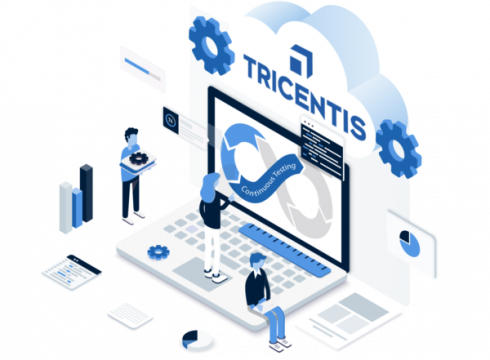
Remember the old adage: “Speed, Cost, Quality– pick any two?” This tradeoff is no longer an option. With digital transformation initiatives driving DevTest teams to scale Agile and adopt DevOps, all three vectors must be addressed. This requires a fundamental shift in how you approach testing. It’s not a matter of acquiring more or better tools; holistic process transformation is required.
That’s why Tricentis defined “continuous testing” and developed the industry-leading continuous testing platform. Organizations turn to Tricentis to make a fundamental process change in that testing process while lowering business risks and accelerating software delivery. Tricentis’ intelligent model-based approach ensures the reliability, flexibility and actionable insights companies needed to accelerate and automate the most demanding delivery cycles.
“Continuous testing ensures that the right stakeholders have access to the right information at the right time. You can execute automated testing as part of the software delivery pipeline and obtain immediate feedback on the business risks associated with a software release,” said Wayne Ariola, chief marketing officer at Tricentis.
Tricentis is among the 2019 SD Times 100 for its leadership in the Testing category and has also been recognized as a “leader” by Forrester, Gartner and IDC. Its continuous testing platform enables organizations to achieve more than 90 percent test automation, 5X or better speed increases and more than 80 percent risk coverage. Tricentis’ successful enablement of continuous testing is further reflected in its 80 percent annual growth rate and over 1,600 global customers. In addition, Tricentis enjoys the largest software distribution among global systems integrators.
Scaled Agile and DevOps require continuous testing
Agile success is easier to achieve with a small project that involves just a web interface. However, as Agile projects scale, the underlying architecture and the necessary testing strategies become more complex. While risk mitigation strategies tend to include shift-left and shift-right, what’s really needed is continuous testing throughout the lifecycle, especially as teams advance to DevOps.
“When you scale Agile, you recognize that you need to radically alter the traditional testing processes. When you move to DevOps, those processes must again scale to an entirely different level of automation,” said Ariola. “As you move down the DevOps path, eventually, you conclude that continuous testing must be executed within the contexts of business objectives and business risks – not just ‘siloed application test results.”
Scaled Agile and DevOps break down when speed and quality imperatives are out of sync. A symptom of that is approaching continuous testing from a tool perspective rather than a process perspective. The former creates process friction while the latter alleviates it.
“You need holistic process transformation to achieve business transformation and DevOps transformation goals,” said Ariola. “A ‘chasm’ that often plagues organizations is the gap between a small team of brilliant, technical people who succeeded with an Agile or DevOps pilot and the larger population necessary to affect scaled Agile or DevOps which is more diverse.”
For a small project with a simple architecture, Selenium scripts or free Selenium-based tools work well. However, when Agile and DevOps scale, the underlying architecture becomes more complex necessitating intelligent, end-to-end continuous testing processes.
Improve user journeys and lower business risks
Consistent user journeys have become more important than individual component outcomes, so software teams need a means of ensuring quality that doesn’t slow value delivery.
“Transformation conversations are tightly aligned with business objectives because companies understand they’re competing with digital natives who are disrupting entire industries,” said Ariola. “Software teams adopted CI to execute builds faster and more consistently. More recently, they’re adopting CD to package and ship quickly and automatically. What’s missing is the governance that can ensure quality across the end-to-end user experience. This is enabled through continuous testing.”
Instead of asking whether testing is “done” yet, organizations should ask whether a release reflects an acceptable level of risk. To achieve that, software teams need to understand what they’re going to release, when they’re going to release it, the level of acceptable business risk and how they’ll measure success.
Using Tricentis, Agile and DevOps teams can measure and govern risk, as well as quickly define and update tests across the architecture. Its model-based testing capabilities propagate a change throughout an entire test suite automatically. Essentially, Tricentis is a low-code, no-code platform that uses advanced algorithms and automation techniques to speed, simplify and improve testing outcomes. AI and machine learning are enabled in the appropriate places so organizations can react to change faster and avoid the overhead of maintaining test scripts.
“Tools don’t solve the problem of testing at scale; process transformation does,” said Ariola. “Tricentis allows you to focus on the holistic problem of end-to-end continuous testing using a business risk approach. We support over 160 different technologies so you can achieve the resiliency, speed and success you seek at scale.”
Learn more at www.tricentis.com.
Content provided by SD Times and Tricentis




